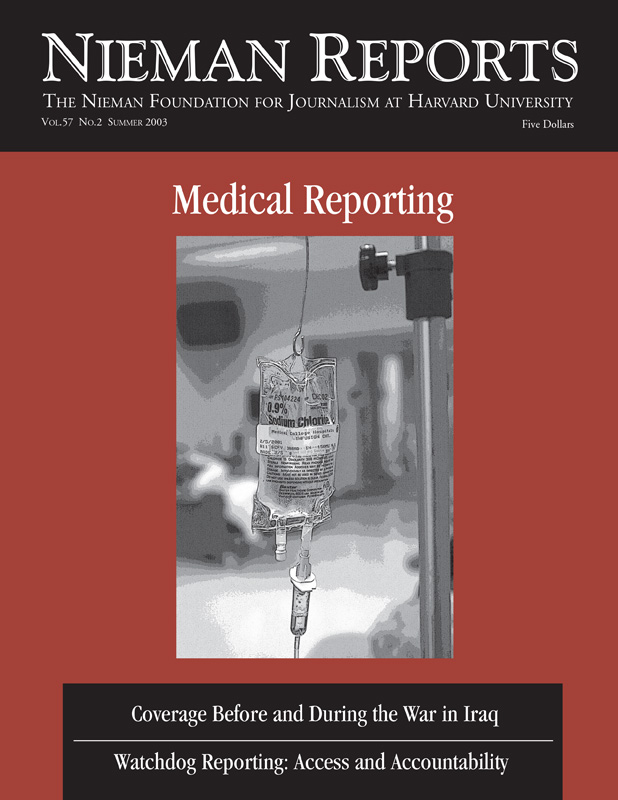After working as a medical journalist for 10 years, I entered medical school and then a residency in internal medicine. To my surprise, I emerged to find a new world of medical journalism. I am encouraged by some aspects of this world but disillusioned by others. It is true that medical journalism, more than ever before, has become an important source of public health education and information. But it is also true that there are problems in the relationship between medical journalists and physicians, including their understanding of each other’s professions.
The chasm between medical journalists and physicians appears mostly to be one of ignorance rather than conflicting interests or malice. But across this divide exist miscommunica-tion, misunderstanding and the potential for misguided messages to the public. Rose-colored glasses may have altered my memory, but I do not recall the caustic attitudes of journalists toward doctors or the skeptical tenor of doctors toward journalists when I was a full-time journalist a decade ago. I remember more professional respect, objective analysis, and collaboration. Perhaps, during the embryonic years of mainstream medical journalism, the parties were more polite, if not forgiving and patient of each other.
The Chasm Widens
The worsening rift first struck me after I finished my medical internship. Working as a freelance journalist, I thought I would be welcomed back into the fold of the fourth estate. Instead, I felt like an outsider. Negative comments about the medical profession seemed commonplace. Likewise, I heard physicians speak of members of the press as if they were not to be trusted.
I listened to routine condemnation of medicine and journalism often framed with incomplete or inaccurate data. Instead of talking about story ideas and interesting science and medicine, journalists railed and postured as if they were protecting the public from a menace. It was as if in covering medicine, they were covering the enemy. Physicians dismissed medical journalists as being too uneducated to understand medicine or too busy to report on it accurately. They worried about the limitations of journalists and the motives of their editors while pointing to manipulation by outside interests. News reports were considered “abbreviated” at best and “sensational” at worst. Doctors accused the media of confusing their patients.
For me, the dispute came into focus at the Mayo Clinic’s Medicine and Media Conference in 2002. One reporter charged that if journalists had not reported on the limitations of arthroscopic surgery that doctors would not have changed their practice of performing arthroscopy for osteoarthritis of the knee.
The journalist in me wanted to say, “Yes, mainstream medical journalists covered that research and informed the public.” But the doctor in me wanted to say, “Doctors designed and conducted that research and a medical journal (The New England Journal of Medicine, July 11, 2002) published the study showing that arthroscopic surgery has no benefit over placebo for the treatment of certain types of os-teoarthritis of the knee.” A change in practice came about because of a collaborative effort instituted by doctors and conveyed to the lay public by journalists.
I began to wonder whether journalists and doctors are oblivious to the importance of their collaboration. And I worried that the negative attitudes they had about one another could threaten similar effective working relationships of the future. Had medicine become the enemy, as some medical journalists thought? Are most medical journalists unable to inform and educate the public accurately on important health matters, as some physicians believed?
In trying to answer these questions, I thought of numerous examples of outstanding work from both fields. In my journey of medical reporting and medical training, I’ve witnessed countless instances of commitment, intelligence and courage from physicians and medical journalists, all working under profound professional stresses. So why the cynical attitudes toward one another?
What To Do About Distrust
No one will dispute the fact that the problems in medicine are vast, from the economic implosion affecting the ability of the profession to fulfill its mission to the limitations of the system to handle all aspects of medical care. Few disagree about the crisis of medical errors or the critical need to improve medical training and health care delivery especially for our aging and poor populations. But journalists and physicians working independently or as adversaries will not solve these problems.
Similarly, most would recognize that medical journalists are under enormous constraints of time, space and background knowledge. Many must cover an unimaginable range of complex medical topics on a day-to-day basis. Journalists must place an inordinate trust in their sources and constantly worry about both missing some aspect of the story and the health implications of informing the public about medicine. Their beat is a moving target, where scientific interpretations and health recommendations change often.
Do doctors and journalists have a responsibility to work together? Can and should they develop a cohesive system to educate and inform the public as well as keep an eye on each other? Shouldn’t they recognize that they share many of the same frustrations and restrictions, as well as ideals and goals? These issues—and others—must be articulated in an intelligent and constructive debate among individuals who have not lost respect for either profession. We must hear from those who will propose and implement effective solutions.
One example of a medical situation that would greatly benefit from collaborative trust and better communication is the diversion of ambulances from hospitals because of overcrowded emergency rooms. This is an important story, but most of the coverage of this issue has not included those inside medicine or public health who could help uncover and explain why the problem exists. Both the complexity and the magnitude of the story were missed. Furthermore, the reactionary “solutions” made by some hospitals in response to newspaper headlines were worse than the original problem. Overwhelmed and understaffed emergency rooms are not better for patients than hospital diversions.
At times, the relationship between doctors and journalists resembles a bad marriage, with equal parts dependence and disdain. Neither group seems to understand nor acknowledge the other’s roles and responsibilities. Ultimately, the public and patients suffer. Perhaps those in medicine who criticize journalists for misleading the public might move away from providing only criticism and begin to find more effective means of improving communication or providing technical assistance to journalists. Whether it is books on epidemiology, symposia on infectious diseases, or other professional development workshops, journalists would welcome the information. Furthermore, for doctors to relinquish the job of public health education and place it solely in the hands of the mainstream press is neither fair nor prudent.
Also, during the Mayo Clinic meeting, one speaker implied that if the press had not covered the hormone replacement study last summer, many gynecologists would not have called their patients or changed their prescribing practices. The hormone replacement study was released in a major medical journal (The Journal of the American Medical Association, July 2002) that is read by physicians and journalists. Such peer-reviewed journals help to set policy and practice standards. Whether the mass media covered the hormone story or not, most agree that medical practice would have changed and patients would have been notified.
Although many important stories are covered in the mainstream press, medicine is not taught in a 30-second sound bite, nor does it generally change on the basis of a newspaper headline. With the hormone replacement study, the media helped get the word to patients but, unfortunately, the complex conclusions of the message and the way it was released might have caused more confusion. If physicians and members of the media had collaborated on how best to get this message to patients and physicians—as suggested in an article, “Menopausal Hormone Therapy: Summary of a Scientific Workshop,” published in the Annals of Internal Medicine (February 18, 2003), everyone might have readily benefited.
Bridging the Chasm
Doctors and medical journalists both define themselves as public servants. They come together at a crossroads of public health. If they are to be patient advocates, they cannot be arch antagonists. They must fulfill their responsibilities to the public through professional cooperation and mutual understanding.
I am not suggesting that they be “yes men” or that they not expose one another’s fallibilities and mistakes. But I do think it best if each becomes knowledgeable about the other’s profession, whether guarding against medical errors in the hospital or in the headlines. This won’t happen if each does not understand the other’s professional training, education, deadlines, responsibilities, codes of ethics, and internal stresses.
Several years ago, I was speaking at a national health journalism conference when a journalist in the audience suggested how counterintuitive it was that a researcher would write a hypothesis before conducting a study and interpreting data. I knew that to do otherwise would be anathema to reputable research. Conversely, to explain to a doctor or clinical scientist why a journalist would never write a headline before they wrote their story might seem odd. Furthermore, to try to explain how a journalist could set out to write one story but then return to their editor with another would be difficult. It might appear even suspect.
Given today’s realities of covering medical news, an important genetic discovery of a lethal disease often needs to be communicated in one-and-a-half minutes or 500 words. There is much at stake in journalists being sure this difficult job is done well since both patients and practitioners have come to rely upon medical journalism to help stay informed.
I must admit that I have heard more criticism from journalists of doctors than doctors of journalists. Of course, this might be related to the nature of a journalist’s work; after all, medical journalists encounter doctors and cover the medical profession nearly every day. Most doctors come into contact with journalists on an irregular basis, if at all.
How are physicians affected by medical journalism? I am completing a research project that assesses physicians’ attitudes about the news media and how medical information in the popular press affects them, their patients, and their practices. I also hope to help these two professions better understand each other. Perhaps my study will facilitate an intelligent and productive discourse between doctors and journalists.
I know firsthand of the promises of both professions. I do not want the current adversarial abyss that lies between them to threaten their potential or harm their work. While keeping our roles and responsibilities distinct and clear, we must begin to build a bridge over the chasm. Only then, will we as doctors and medical journalists truly serve the public and our professions.
Terry L. Schraeder, M.D., was the medical reporter for WCVB-TV (ABC-Boston) from 1986-1995 and has also written for The Boston Globe and other print and broadcast outlets. She graduated from Tufts University School of Medicine in 1999. As a Henry J. Kaiser Family Foundation Fellow 2000-2001 she began research on medicine and media. Schraeder will finish her training in internal medicine at Mt. Auburn Hospital in Cambridge in 2003. She is currently a fellow at The New England Journal of Medicine.



